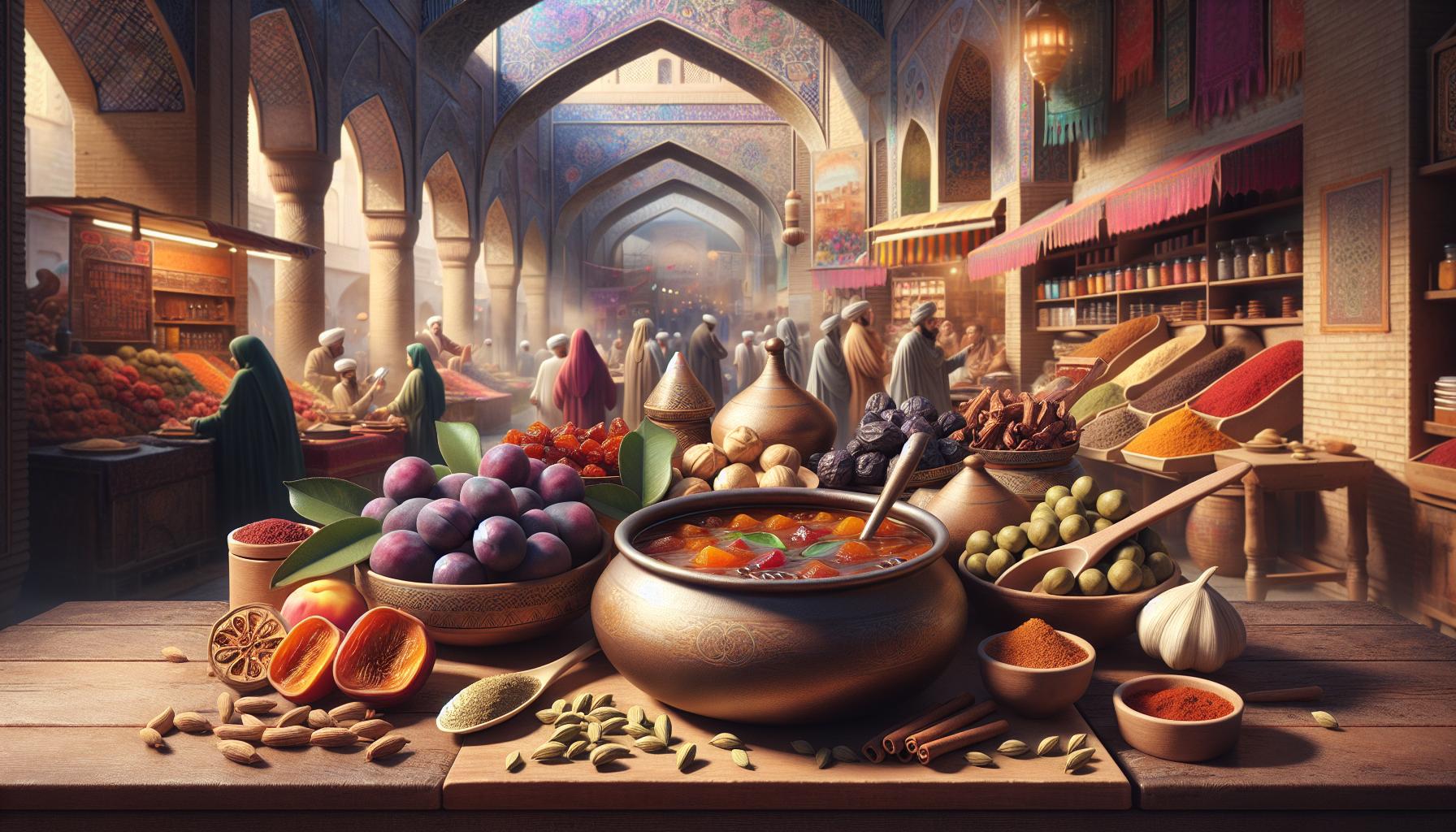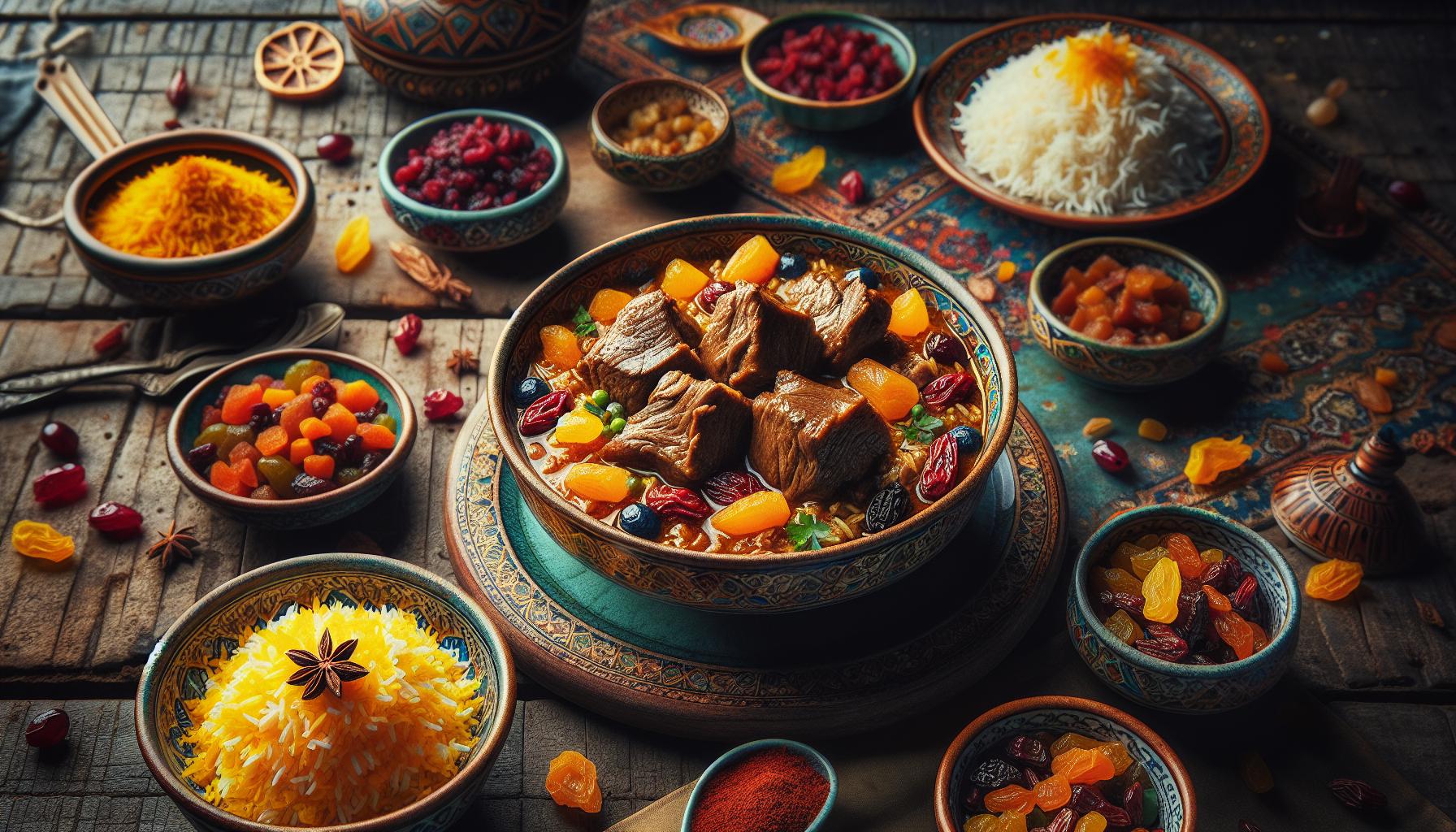Ever wonder why some Persian dishes have that perfect balance of sweet and savory? Kajvazhishaz, a traditional Iranian delicacy, stands out as one of those culinary mysteries that’s been captivating taste buds for centuries. This unique dish combines tender lamb, aromatic spices and a secret blend of dried fruits that’ll make any food enthusiast weak in the knees. In the bustling markets of Tehran, locals swear by kajvazhishaz as their go-to comfort food during cold winter months. It’s not just another stew – it’s a celebration of Persian culinary artistry that brings families together and turns ordinary dinners into memorable feasts. While its name might be a tongue-twister for some, its flavors speak a universal language that food lovers worldwide understand and appreciate.
Kajvazhishaz
Kajvazhishaz emerges as a cherished Persian stew featuring tender lamb combined with dried fruits in a caramelized onion base. Its foundation rests on three core ingredients: marinated lamb shoulder, a medley of sun-dried fruits, and Persian spices including saffron, cardamom, and cinnamon. The name “kajvazhishaz” translates to “crooked cooking pot” in Persian, referencing the traditional clay vessel used in its preparation. Each region across Iran incorporates local variations of dried fruits such as apricots, plums, or golden raisins into the dish. The preparation involves:-
- Marinating lamb chunks in yogurt saffron mixture for 6 hours
-
- Caramelizing onions with Persian spices for 25 minutes
-
- Slow-cooking the meat until tender for 2 hours
-
- Adding dried fruits during the final 30 minutes
| Ingredient | Quantity | Purpose |
|---|---|---|
| Lamb shoulder | 2 pounds | Main protein |
| Dried fruits | 1.5 cups | Natural sweetness |
| Saffron | 2 grams | Color and aroma |
| Caramelized onions | 3 cups | Base flavor |
| Persian spices | 4 tablespoons | Signature taste |
The Ancient Origins of Kajvazhishaz

Historical Significance
The earliest documented mention of kajvazhishaz appears in a 9th-century Persian manuscript detailing royal court recipes. Persian nobility served this dish at ceremonial feasts, using specific clay vessels crafted by skilled artisans in Mazandaran. Trade routes through the Silk Road introduced new spices into the recipe, including cardamom from India and cinnamon from Ceylon. Royal kitchen records from the Safavid period (1501-1736) reveal that kajvazhishaz preparation required three specialized cooks: a meat master, a spice blender and a fruit curator. The distinctive cooking method emerged from necessity, as slow-cooking in curved pots preserved precious cooking fuel while tenderizing tough cuts of meat.Cultural Impact
Kajvazhishaz symbolizes Persian hospitality through generations of family gatherings. The dish features prominently in Persian poetry, with verses from Omar Khayyam celebrating its aromatic complexity. Regional variations across Iran reflect local fruit preferences: Kermanshah uses dried plums, while Shiraz incorporates local figs. Traditional Persian weddings include kajvazhishaz as a symbol of abundance and prosperity. The preparation process creates social bonds as families gather to select fruits and prepare ingredients. Markets in Tehran’s Grand Bazaar maintain dedicated spice merchants who preserve historical kajvazhishaz spice blend recipes. Modern Iranian restaurants showcase kajvazhishaz as an emblem of Persian culinary heritage, attracting international recognition for its unique flavor profile.Key Elements of Kajvazhishaz Practice
The authentic preparation of kajvazhishaz centers on specific elements that ensure its distinctive taste profile. These elements combine traditional Persian cooking methods with precise ingredient ratios.Core Principles
-
- Meat Selection: Using lamb shoulder cuts with optimal fat marbling produces tender results
-
- Fruit Balance: Combining 3-4 types of dried fruits creates layered sweetness
-
- Spice Composition: Adding Persian spices in a specific order:
-
- Saffron infusion at marination
-
- Cinnamon bark during meat cooking
-
- Ground cardamom in final stages
-
- Temperature Control: Maintaining precise heat levels:
-
- Initial sear: 400°F (204°C)
-
- Slow cooking: 275°F (135°C)
-
- Moisture Management: Adding liquid in 1/2 cup increments preserves sauce consistency
-
- Timing Sequence: Following strict cooking intervals:
-
- Marination: 8 hours
-
- Onion caramelization: 45 minutes
-
- Meat cooking: 2.5 hours
-
- Fruit incorporation: 30 minutes
-
- Clay Pot Usage:
-
- Seasoning new pots with oil rubs
-
- Preheating empty vessels gradually
-
- Rotating pot position for even heat distribution
-
- Fruit Preparation Methods:
-
- Soaking dried fruits in warm water for 20 minutes
-
- Layering fruits based on density
-
- Adding robust fruits first followed by delicate ones
-
- Onion Base Creation:
-
- Slicing onions in uniform 1/8-inch rings
-
- Caramelizing in ghee at low temperature
-
- Building flavor layers through controlled browning
-
- Marination Process:
-
- Yogurt-saffron paste coating
-
- Room temperature rest periods
-
- Periodic meat turning for even absorption
Modern Applications of Kajvazhishaz
Kajvazhishaz adapts to contemporary culinary trends while maintaining its traditional essence. The dish integrates modern cooking technologies with time-honored Persian flavors.Contemporary Uses
Electric slow cookers transform kajvazhishaz preparation into a convenient 6-hour process. Professional chefs incorporate molecular gastronomy techniques to create deconstructed versions, featuring lamb spheres surrounded by fruit gel pearls. Meal preparation services offer pre-portioned kajvazhishaz kits containing measured spices, vacuum-sealed lamb cuts, and premium dried fruits. Restaurant chains feature fusion interpretations, combining kajvazhishaz elements with local ingredients like truffle oil or balsamic reduction. Food manufacturers produce ready-to-heat kajvazhishaz in vacuum-sealed pouches, targeting busy urban professionals.Global Adoption
International restaurants adapt kajvazhishaz to local palates across 15 countries. European chefs pair the dish with regional wines, creating specialized tasting menus in Michelin-starred establishments. American food trucks serve kajvazhishaz-inspired sandwiches, combining shredded lamb with fruit compotes. Asian fusion restaurants incorporate local fruits like lychee or dried mango into the traditional recipe. Australian gastropubs offer kajvazhishaz meat pies, featuring the classic flavors in portable form. Social media influencers generate 500,000+ monthly views showcasing kajvazhishaz recipes on platforms like TikTok Instagram.Benefits and Limitations
Kajvazhishaz offers significant nutritional benefits through its protein-rich lamb content and antioxidant-packed dried fruits. Lamb provides essential amino acids and iron, while dried fruits contribute fiber and vitamins A, C, and E. The slow-cooking method preserves nutrients and enhances the bioavailability of minerals.Key Benefits:
-
- Balanced protein content from tender lamb
-
- High fiber intake from mixed dried fruits
-
- Rich source of essential minerals (iron, zinc, magnesium)
-
- Natural antioxidants from saffron and spices
-
- Complex carbohydrates for sustained energy
Culinary Advantages:
-
- Batch cooking potential for multiple meals
-
- Freezer-friendly storage options
-
- Versatile serving combinations with rice or bread
-
- Enhanced flavor development during reheating
-
- Cost-effective use of tough meat cuts
Preparation Constraints:
-
- Extended cooking time (4-6 hours)
-
- Limited availability of authentic Persian spices
-
- Specific equipment requirements for traditional preparation
-
- Complex timing for fruit additions
-
- Storage space needed for multiple ingredients
-
- High caloric content per serving
-
- Concentrated sugar levels from dried fruits
-
- Limited vegetarian adaptation options
-
- Allergenic concerns with specific dried fruits
-
- Salt content from traditional preparation

